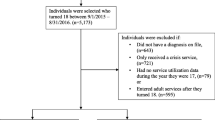Abstract
The mental health histories of the 448 children 15 and 16 years of age who were admitted to state-operated children's psychiatric inpatient services in New York during 1982 were reviewed for the 11 year period through April 1993, Thirty-three percent were served as adults (after age 18) in the state-operated adult civil mental health system; 42% of these individuals were still receiving services at the end of the period. 113 of the 146 individuals served as adults were served only in the civil system. Thirteen percent of the cohort received some of their mental health services as adults in the state-operated adult forensic mental health system due to criminal law involvement. This includes nine percent who received mental health services while they were inmates in state prisons. Twenty four of the 57 forensic clients received services as adults only in the forensic system. Diagnostic, demographic, and service history characteristics of the groups were compared to foster an early understanding of policy and programmatic issues related to movement from the child mental health system to the adult system. Baseline (1982) information was used to identify predictors of later service utilization.
Similar content being viewed by others
REFERENCES
Dvoskin, J. A., & Steadman, H. (1994). Using intensive case management to reduce violence by mentally ill persons in the community. Hospital and Community Psychiatry, 45, 679–684.
Koroloff, N. M. (1990). Moving out: Transition policies for youth with serious emotional disabilities. Journal of Mental Health Administration, 17, 78–86.
Henggeler, S. W., Melton, G. B., & Smith, L. A. (1992). Family preservation using multisystemic therapy: An effective alternative to incarceration of serious juvenile offenders. Journal of Consulting and Clinical Psychology, 60, 953–961.
Modrcin, M.J. (1989). Emotionally handicapped youth in transition: Issues and principles for program development. Community Mental Health Journal, 25, 219–227.
New York State Office of Mental Health. (1991). Patient characteristics survey analysis. Albany, NY: Author.
New York City Department of Mental Health, Mental Retardation, and Alcoholism Services. (1990). The Commissioner's Task Force report on mental health services for children and adolescents. New York, NY: Author.
Stroul, B.A., & Friedman, R.M. (1986). Claiming the unclaimed children: Guidelines for a system of care for severely emotionally disturbed children and their families. Washington, DC: CASSP Technical Assistance Center, Georgetown University Child Development Center.
Rights and permissions
About this article
Cite this article
Way, B.B., McCormick, C.T., Evans, M.E. et al. Where Have All the Children Gone? Movement from Child to Adult Mental Health Systems. Journal of Child and Family Studies 6, 57–67 (1997). https://doi.org/10.1023/A:1025020707237
Issue Date:
DOI: https://doi.org/10.1023/A:1025020707237




